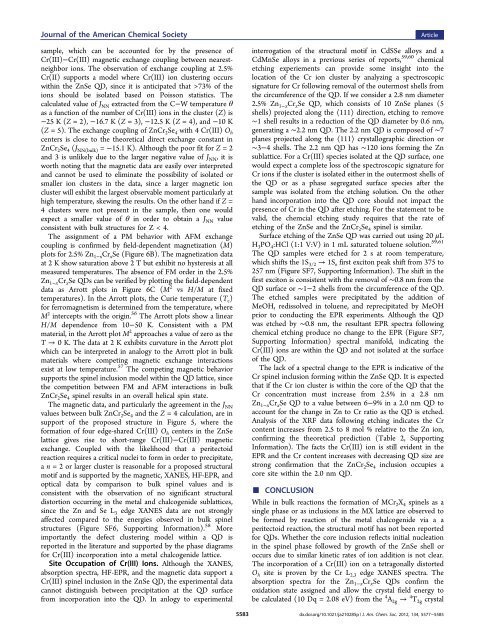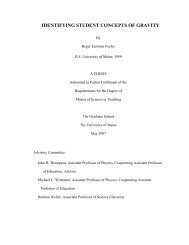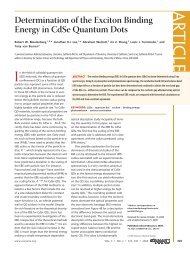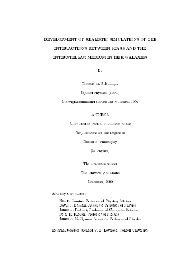Evidence of a ZnCr2Se4 Spinel Inclusion at the Core of a Cr-Doped ...
Evidence of a ZnCr2Se4 Spinel Inclusion at the Core of a Cr-Doped ...
Evidence of a ZnCr2Se4 Spinel Inclusion at the Core of a Cr-Doped ...
Create successful ePaper yourself
Turn your PDF publications into a flip-book with our unique Google optimized e-Paper software.
Journal <strong>of</strong> <strong>the</strong> American Chemical Society<br />
sample, which can be accounted for by <strong>the</strong> presence <strong>of</strong><br />
<strong>Cr</strong>(III)−<strong>Cr</strong>(III) magnetic exchange coupling between nearestneighbor<br />
ions. The observ<strong>at</strong>ion <strong>of</strong> exchange coupling <strong>at</strong> 2.5%<br />
<strong>Cr</strong>(II) supports a model where <strong>Cr</strong>(III) ion clustering occurs<br />
within <strong>the</strong> ZnSe QD, since it is anticip<strong>at</strong>ed th<strong>at</strong> >73% <strong>of</strong> <strong>the</strong><br />
ions should be isol<strong>at</strong>ed based on Poisson st<strong>at</strong>istics. The<br />
calcul<strong>at</strong>ed value <strong>of</strong> J NN extracted from <strong>the</strong> C−W temper<strong>at</strong>ure θ<br />
as a function <strong>of</strong> <strong>the</strong> number <strong>of</strong> <strong>Cr</strong>(III) ions in <strong>the</strong> cluster (Z) is<br />
−25 K (Z = 2), −16.7 K (Z = 3), −12.5 K (Z = 4), and −10 K<br />
(Z = 5). The exchange coupling <strong>of</strong> Zn<strong>Cr</strong> 2 Se 4 with 4 <strong>Cr</strong>(III) O h<br />
centers is close to <strong>the</strong> <strong>the</strong>oretical direct exchange constant in<br />
Zn<strong>Cr</strong> 2 Se 4 (J NN(bulk) = −15.1 K). Although <strong>the</strong> poor fit for Z =2<br />
and 3 is unlikely due to <strong>the</strong> larger neg<strong>at</strong>ive value <strong>of</strong> J NN ,itis<br />
worth noting th<strong>at</strong> <strong>the</strong> magnetic d<strong>at</strong>a are easily over interpreted<br />
and cannot be used to elimin<strong>at</strong>e <strong>the</strong> possibility <strong>of</strong> isol<strong>at</strong>ed or<br />
smaller ion clusters in <strong>the</strong> d<strong>at</strong>a, since a larger magnetic ion<br />
cluster will exhibit <strong>the</strong> largest observable moment particularly <strong>at</strong><br />
high temper<strong>at</strong>ure, skewing <strong>the</strong> results. On <strong>the</strong> o<strong>the</strong>r hand if Z =<br />
4 clusters were not present in <strong>the</strong> sample, <strong>the</strong>n one would<br />
expect a smaller value <strong>of</strong> θ in order to obtain a J NN value<br />
consistent with bulk structures for Z < 4.<br />
The assignment <strong>of</strong> a PM behavior with AFM exchange<br />
coupling is confirmed by field-dependent magnetiz<strong>at</strong>ion (M)<br />
plots for 2.5% Zn 1−x <strong>Cr</strong> x Se (Figure 6B). The magnetiz<strong>at</strong>ion d<strong>at</strong>a<br />
<strong>at</strong> 2 K show s<strong>at</strong>ur<strong>at</strong>ion above 2 T but exhibit no hysteresis <strong>at</strong> all<br />
measured temper<strong>at</strong>ures. The absence <strong>of</strong> FM order in <strong>the</strong> 2.5%<br />
Zn 1−x <strong>Cr</strong> x Se QDs can be verified by plotting <strong>the</strong> field-dependent<br />
d<strong>at</strong>a as Arrott plots in Figure 6C (M 2 vs H/M <strong>at</strong> fixed<br />
temper<strong>at</strong>ures). In <strong>the</strong> Arrott plots, <strong>the</strong> Curie temper<strong>at</strong>ure (T c )<br />
for ferromagnetism is determined from <strong>the</strong> temper<strong>at</strong>ure, where<br />
M 2 intercepts with <strong>the</strong> origin. 56 The Arrott plots show a linear<br />
H/M dependence from 10−50 K. Consistent with a PM<br />
m<strong>at</strong>erial, in <strong>the</strong> Arrott plot M 2 approaches a value <strong>of</strong> zero as <strong>the</strong><br />
T → 0 K. The d<strong>at</strong>a <strong>at</strong> 2 K exhibits curv<strong>at</strong>ure in <strong>the</strong> Arrott plot<br />
which can be interpreted in analogy to <strong>the</strong> Arrott plot in bulk<br />
m<strong>at</strong>erials where competing magnetic exchange interactions<br />
exist <strong>at</strong> low temper<strong>at</strong>ure. 57 The competing magnetic behavior<br />
supports <strong>the</strong> spinel inclusion model within <strong>the</strong> QD l<strong>at</strong>tice, since<br />
<strong>the</strong> competition between FM and AFM interactions in bulk<br />
Zn<strong>Cr</strong> 2 Se 4 spinel results in an overall helical spin st<strong>at</strong>e.<br />
The magnetic d<strong>at</strong>a, and particularly <strong>the</strong> agreement in <strong>the</strong> J NN<br />
values between bulk Zn<strong>Cr</strong> 2 Se 4 and <strong>the</strong> Z = 4 calcul<strong>at</strong>ion, are in<br />
support <strong>of</strong> <strong>the</strong> proposed structure in Figure 5, where <strong>the</strong><br />
form<strong>at</strong>ion <strong>of</strong> four edge-shared <strong>Cr</strong>(III) O h centers in <strong>the</strong> ZnSe<br />
l<strong>at</strong>tice gives rise to short-range <strong>Cr</strong>(III)−<strong>Cr</strong>(III) magnetic<br />
exchange. Coupled with <strong>the</strong> likelihood th<strong>at</strong> a peritectoid<br />
reaction requires a critical nuclei to form in order to precipit<strong>at</strong>e,<br />
a n = 2 or larger cluster is reasonable for a proposed structural<br />
motif and is supported by <strong>the</strong> magnetic, XANES, HF-EPR, and<br />
optical d<strong>at</strong>a by comparison to bulk spinel values and is<br />
consistent with <strong>the</strong> observ<strong>at</strong>ion <strong>of</strong> no significant structural<br />
distortion occurring in <strong>the</strong> metal and chalcogenide subl<strong>at</strong>tices,<br />
since <strong>the</strong> Zn and Se L 3 edge XANES d<strong>at</strong>a are not strongly<br />
affected compared to <strong>the</strong> energies observed in bulk spinel<br />
structures (Figure SF6, Supporting Inform<strong>at</strong>ion). 58 More<br />
importantly <strong>the</strong> defect clustering model within a QD is<br />
reported in <strong>the</strong> liter<strong>at</strong>ure and supported by <strong>the</strong> phase diagrams<br />
for <strong>Cr</strong>(III) incorpor<strong>at</strong>ion into a metal chalcogenide l<strong>at</strong>tice.<br />
Site Occup<strong>at</strong>ion <strong>of</strong> <strong>Cr</strong>(III) Ions. Although <strong>the</strong> XANES,<br />
absorption spectra, HF-EPR, and <strong>the</strong> magnetic d<strong>at</strong>a support a<br />
<strong>Cr</strong>(III) spinel inclusion in <strong>the</strong> ZnSe QD, <strong>the</strong> experimental d<strong>at</strong>a<br />
cannot distinguish between precipit<strong>at</strong>ion <strong>at</strong> <strong>the</strong> QD surface<br />
from incorpor<strong>at</strong>ion into <strong>the</strong> QD. In anlogy to experimental<br />
Article<br />
interrog<strong>at</strong>ion <strong>of</strong> <strong>the</strong> structural motif in CdSSe alloys and a<br />
CdMnSe alloys in a previous series <strong>of</strong> reports, 59,60 chemical<br />
etching experiements can provide some insight into <strong>the</strong><br />
loc<strong>at</strong>ion <strong>of</strong> <strong>the</strong> <strong>Cr</strong> ion cluster by analyzing a spectroscopic<br />
sign<strong>at</strong>ure for <strong>Cr</strong> following removal <strong>of</strong> <strong>the</strong> outermost shells from<br />
<strong>the</strong> circumference <strong>of</strong> <strong>the</strong> QD. If we consider a 2.8 nm diameter<br />
2.5% Zn 1−x <strong>Cr</strong> x Se QD, which consists <strong>of</strong> 10 ZnSe planes (5<br />
shells) projected along <strong>the</strong> ⟨111⟩ direction, etching to remove<br />
∼1 shell results in a reduction <strong>of</strong> <strong>the</strong> QD diameter by 0.6 nm,<br />
gener<strong>at</strong>ing a ∼2.2 nm QD. The 2.2 nm QD is composed <strong>of</strong> ∼7<br />
planes projected along <strong>the</strong> ⟨111⟩ crystallographic direction or<br />
∼3−4 shells. The 2.2 nm QD has ∼120 ions forming <strong>the</strong> Zn<br />
subl<strong>at</strong>tice. For a <strong>Cr</strong>(III) species isol<strong>at</strong>ed <strong>at</strong> <strong>the</strong> QD surface, one<br />
would expect a complete loss <strong>of</strong> <strong>the</strong> spectroscopic sign<strong>at</strong>ure for<br />
<strong>Cr</strong> ions if <strong>the</strong> cluster is isol<strong>at</strong>ed ei<strong>the</strong>r in <strong>the</strong> outermost shells <strong>of</strong><br />
<strong>the</strong> QD or as a phase segreg<strong>at</strong>ed surface species after <strong>the</strong><br />
sample was isol<strong>at</strong>ed from <strong>the</strong> etching solution. On <strong>the</strong> o<strong>the</strong>r<br />
hand incorpor<strong>at</strong>ion into <strong>the</strong> QD core should not impact <strong>the</strong><br />
presence <strong>of</strong> <strong>Cr</strong> in <strong>the</strong> QD after etching. For <strong>the</strong> st<strong>at</strong>ement to be<br />
valid, <strong>the</strong> chemcial etching study requires th<strong>at</strong> <strong>the</strong> r<strong>at</strong>e <strong>of</strong><br />
etching <strong>of</strong> <strong>the</strong> ZnSe and <strong>the</strong> Zn<strong>Cr</strong> 2 Se 4 spinel is similar.<br />
Surface etching <strong>of</strong> <strong>the</strong> ZnSe QD was carried out using 20 μL<br />
H 3 PO 4 :HCl (1:1 V:V) in 1 mL s<strong>at</strong>ur<strong>at</strong>ed toluene solution. 59,61<br />
The QD samples were etched for 2 s <strong>at</strong> room temper<strong>at</strong>ure,<br />
which shifts <strong>the</strong> 1S 3/2 → 1S e first exciton peak shift from 375 to<br />
257 nm (Figure SF7, Supporting Inform<strong>at</strong>ion). The shift in <strong>the</strong><br />
first exciton is consistent with <strong>the</strong> removal <strong>of</strong> ∼0.8 nm from <strong>the</strong><br />
QD surface or ∼1−2 shells from <strong>the</strong> circumference <strong>of</strong> <strong>the</strong> QD.<br />
The etched samples were precipit<strong>at</strong>ed by <strong>the</strong> addition <strong>of</strong><br />
MeOH, redissolved in toluene, and reprecipit<strong>at</strong>ed by MeOH<br />
prior to conducting <strong>the</strong> EPR experiments. Although <strong>the</strong> QD<br />
was etched by ∼0.8 nm, <strong>the</strong> resultant EPR spectra following<br />
chemical etching produce no change to <strong>the</strong> EPR (Figure SF7,<br />
Supporting Inform<strong>at</strong>ion) spectral manifold, indic<strong>at</strong>ing <strong>the</strong><br />
<strong>Cr</strong>(III) ions are within <strong>the</strong> QD and not isol<strong>at</strong>ed <strong>at</strong> <strong>the</strong> surface<br />
<strong>of</strong> <strong>the</strong> QD.<br />
The lack <strong>of</strong> a spectral change to <strong>the</strong> EPR is indic<strong>at</strong>ive <strong>of</strong> <strong>the</strong><br />
<strong>Cr</strong> spinel inclusion forming within <strong>the</strong> ZnSe QD. It is expected<br />
th<strong>at</strong> if <strong>the</strong> <strong>Cr</strong> ion cluster is within <strong>the</strong> core <strong>of</strong> <strong>the</strong> QD th<strong>at</strong> <strong>the</strong><br />
<strong>Cr</strong> concentr<strong>at</strong>ion must increase from 2.5% in a 2.8 nm<br />
Zn 1−x <strong>Cr</strong> x Se QD to a value between 6−9% in a 2.0 nm QD to<br />
account for <strong>the</strong> change in Zn to <strong>Cr</strong> r<strong>at</strong>io as <strong>the</strong> QD is etched.<br />
Analysis <strong>of</strong> <strong>the</strong> XRF d<strong>at</strong>a following etching indic<strong>at</strong>es <strong>the</strong> <strong>Cr</strong><br />
content increases from 2.5 to 8 mol % rel<strong>at</strong>ive to <strong>the</strong> Zn ion,<br />
confirming <strong>the</strong> <strong>the</strong>oretical prediction (Table 2, Supporting<br />
Inform<strong>at</strong>ion). The facts <strong>the</strong> <strong>Cr</strong>(III) ion is still evident in <strong>the</strong><br />
EPR and <strong>the</strong> <strong>Cr</strong> content increases with decreasing QD size are<br />
strong confirm<strong>at</strong>ion th<strong>at</strong> <strong>the</strong> Zn<strong>Cr</strong> 2 Se 4 inclusion occupies a<br />
core site within <strong>the</strong> 2.0 nm QD.<br />
■ CONCLUSION<br />
While in bulk reactions <strong>the</strong> form<strong>at</strong>ion <strong>of</strong> M<strong>Cr</strong> 2 X 4 spinels as a<br />
single phase or as inclusions in <strong>the</strong> MX l<strong>at</strong>tice are observed to<br />
be formed by reaction <strong>of</strong> <strong>the</strong> metal chalcogenide via a a<br />
peritectoid reaction, <strong>the</strong> structural motif has not been reported<br />
for QDs. Whe<strong>the</strong>r <strong>the</strong> core inclusion reflects initial nucle<strong>at</strong>ion<br />
in <strong>the</strong> spinel phase followed by growth <strong>of</strong> <strong>the</strong> ZnSe shell or<br />
occurs due to similar kinetic r<strong>at</strong>es <strong>of</strong> ion addition is not clear.<br />
The incorpor<strong>at</strong>ion <strong>of</strong> a <strong>Cr</strong>(III) ion on a tetragonally distorted<br />
O h site is proven by <strong>the</strong> <strong>Cr</strong> L 2,3 edge XANES spectra. The<br />
absorption spectra for <strong>the</strong> Zn 1−x <strong>Cr</strong> x Se QDs confirm <strong>the</strong><br />
oxid<strong>at</strong>ion st<strong>at</strong>e assigned and allow <strong>the</strong> crystal field energy to<br />
be calcul<strong>at</strong>ed (10 Dq = 2.08 eV) from <strong>the</strong> 4 A 2g → 4 T 2g crystal<br />
5583<br />
dx.doi.org/10.1021/ja210285p | J. Am. Chem. Soc. 2012, 134, 5577−5585






